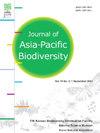药用植物星形蕨科(asteroidea, Asteraceae)全叶绿体基因组特征及其系统发育分析
IF 0.7
Q4 BIODIVERSITY CONSERVATION
引用次数: 0
摘要
本文对菊科植物Duhaldea nervosa (Asteroideae, Asteraceae)的叶绿体基因组进行了从头组装和分析,该基因组为四部结构,总长度为150,916碱基对(bps)。它由一对反向重复序列(IRa和IRb各为24,927 bp)组成,将小单拷贝(18,188 bp)和大单拷贝(82,874 bp)区分开。基因组包含112个独特基因,包括4个核糖体RNA, 79个蛋白质编码基因(CDS)和29个转移RNA基因。对79个种的系统发育分析表明,D. nervosa与Duhaldea cappa有亲缘关系,属于因纽莱科(Inuleae)。在部落水平上,我们的系统发育发现“菊科与菊花科”和“Gnaphalieae与calendleae”具有姐妹关系,并以Senecioneae为根。本研究提高了对菊科植物cp基因组进化和系统发育的认识。本文章由计算机程序翻译,如有差异,请以英文原文为准。
Characterization of the complete chloroplast genome of medicinal species Duhaldea nervosa (Asteroideae, Asteraceae) and its phylogenetic analysis
Here, we de novo assembled and analyzed the chloroplast (cp) genome of Duhaldea nervosa (Asteroideae, Asteraceae) that showed a quadripartite structure with a total length of 150,916 base pairs (bps). It consisted of a pair of inverted repeats (IRa and IRb each of 24,927 bp), which separated the small single copy (18,188 bp) and large single copy (82,874 bp) regions. The genome contained 112 unique genes, including 4 ribosomal RNA, 79 protein-coding genes (CDS), and 29 transfer RNA genes. Phylogenetic analysis among 79 species revealed a sister relationship between D. nervosa and Duhaldea cappa, which lay within the tribe Inuleae. At the tribal level, our phylogenetic findings indicated a sister relationship of “Astereae with Anthemideae” and “Gnaphalieae with Calenduleae” and rooted by Senecioneae. This study enhanced the understanding of cp genome evolution and phylogeny within the Asteraceae family.
求助全文
通过发布文献求助,成功后即可免费获取论文全文。
去求助
来源期刊

Journal of Asia-Pacific Biodiversity
Agricultural and Biological Sciences-Insect Science
CiteScore
1.70
自引率
12.50%
发文量
94
审稿时长
27 days
期刊介绍:
The Journal of Asia-Pacific Biodiversity (previous title was Journal of Korean Nature) is an official journal of National Science Museum of Korea (NSMK) and Korea National Arboretum (KNA). The scope of journal is wide and multidisciplinary that publishes original research papers, review articles, as well as conceptual, technical and methodological papers on all aspects of biological diversity-its description, analysis and conservation, and its application by humankind. This wide and multidisciplinary journal aims to provide both scientists and practitioners in conservation theory, policy and management with comprehensive and applicable information. However, papers should not be submitted that deal with microorganisms, except in invited paper. Articles that are focused on the social and economical aspects of biodiversity will be normally not accepted.
 求助内容:
求助内容: 应助结果提醒方式:
应助结果提醒方式:


